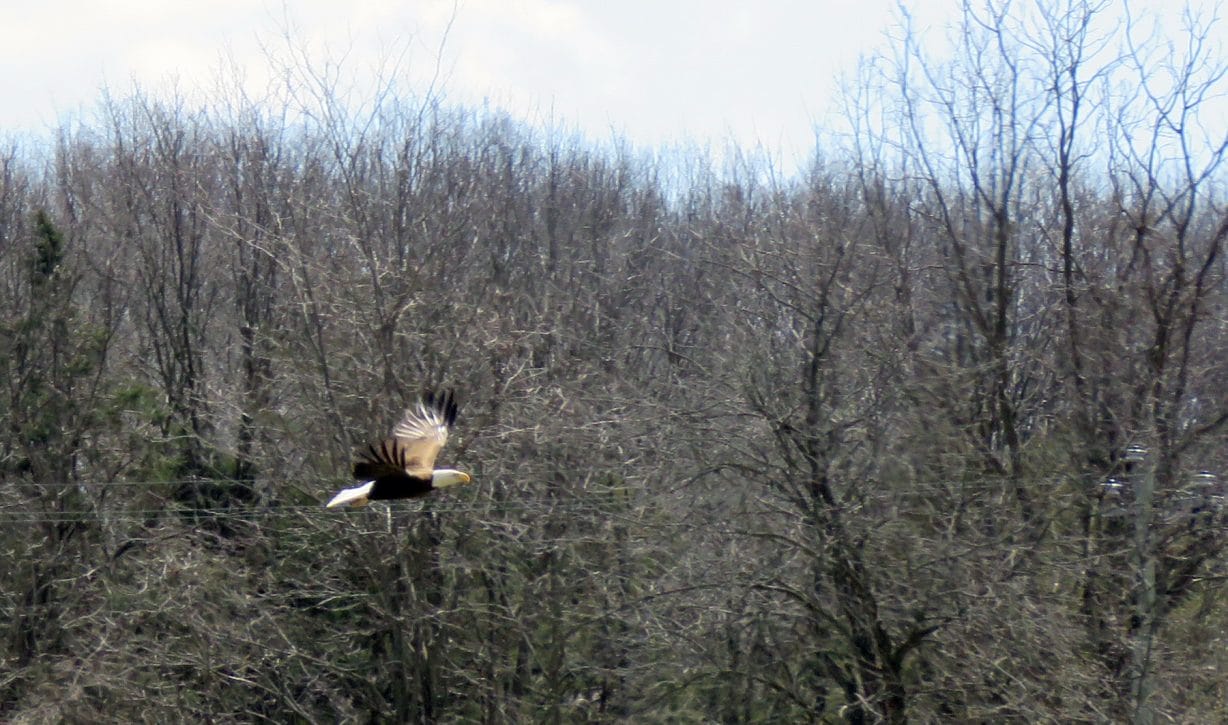
By Bruce Stambaugh, contributor
At first, I did a double-take.
My wife and I had just turned the corner from Rawley Pike south onto Erickson Avenue, just west of Harrisonburg on Sunday. As we passed the Word Ministries Christian Church entrance, I noticed two large birds to my left, south of the church.
Both birds furiously flapped their wings. But there was something extraordinary about what we were seeing. My wife observed that they both appeared to have white heads.
I initially thought we were watching two bald eagles interacting. But the eagle was riding the back of the other bird, steadily forcing it to the ground. I tried to keep an eye on the plummeting birds while slowly driving. Fortunately, there was no traffic.
The birds, still locked together, disappeared from view because the roadway was below the level of the sloping land. We were on our way home from church, so I dropped off my wife at the house, grabbed my camera and binoculars, and hurried back to the scene.
The birds had flown northwest over the woods behind the Crossroads Heritage Center on Garbers Church Road. The hostile interaction began when they got to the clearing south of the church.
I drove to the southwest corner of the parking lot and, from my vehicle, immediately spotted the bald eagle sitting in the open field. Through my binoculars, I saw the other bird. It was an osprey, looking directly toward the eagle.
Within a minute, the eagle flew up and began circling overhead in vast swaths. I drove closer to the osprey. It was clear that this beautiful bird of prey was severely injured.
Ospreys and bald eagles often use the same habitat because both species are skilled at plucking fish from bodies of water. If one catches a fish, the other will pester the bird with its lunch to get it to drop it. Usually, it’s the eagle that chases the osprey.
But we were nowhere near a large stream, lake or pond. I wondered what happened to cause the eagle to be so aggressive toward the osprey. I took some photos and then turned my attention to finding help for the poor bird.
I posted on the Rockingham Bird Club Facebook page about my dilemma. Within minutes, birders suggested I contact the Wildlife Center of Virginia in Waynesboro. That’s what I did.
Because it was a Sunday, I expected the call to go to voicemail. But on the second ring, a woman answered. I explained the situation, and she sent me a text with five names and phone numbers of trained wildlife rescue transporters to contact.
Meanwhile, word quickly spread in the local birding network. Black vultures, American crows, and common grackles began circling overhead. A Cooper’s hawk zoomed by and landed in a nearby tree. The eagle was gone.
The first transporter I called answered right away. Unfortunately, she couldn’t help because she was driving to her daughter’s bridal shower. None of the other people responded.
Then I thought of Clair. I should have called him right away. Clair Mellinger is a retired biology professor emeritus from Eastern Mennonite University, and he lives just a quarter of a mile away.
Fortunately, he was home, and he told me that he was a trained transporter and had taken birds to the Wildlife Center before. He and his wife arrived in a few minutes.
Ospreys have razor-sharp talons and a sharp beak designed to tear apart the flesh of the prey they catch. Mellinger was ready. His pants were tucked into his hiking boots. He wore a thick jacket and gloves and carried a blanket to throw over the bird.
As he approached the osprey, he could see just how badly injured the bird was. Its left wing was broken, and it wasn’t able to walk. So, picking up the bird was easier than we had expected.
The bird didn’t squawk or even try to move as Mellinger carefully carried the Osprey to the trunk of his car. He placed it in a plastic milk crate, put another one on top, and bound the two with bungee cords.
Before he left, Mellinger told me that he had never known an eagle to be so aggressive. The injuries were that serious.
I hoped the osprey and its human escorts were on their way to a good outcome. The Virginia Wildlife Center is a noted rehab center.
Unfortunately, the eagle so severely injured the osprey, there was nothing the veterinarian at the center could do. An email informed me that the bird died in surgery the next day.
As an avid amateur birder, the news saddened me. I was happy to have an expert and trained birder like Clair Mellinger to call on in this time of urgent need. And I was grateful to the rehab center for their efforts in trying to save the osprey.
Mellinger told me that he figured that the osprey was on its northern migration and passed through the eagle’s territory. Nesting eagles in the Shenandoah Valley are either currently incubating eggs or feeding young that have hatched. That might have accounted for the once-in-a-lifetime altercation that my wife and I witnessed. We only wished the events would have had a better outcome for the osprey.
Journalism is changing, and that’s why The Citizen is here. We’re independent. We’re local. We pay our contributors, and the money you give goes directly to the reporting. No overhead. No printing costs. Just facts, stories and context. We’re also a proud member of the Virginia Press Association. Thanks for your support.
